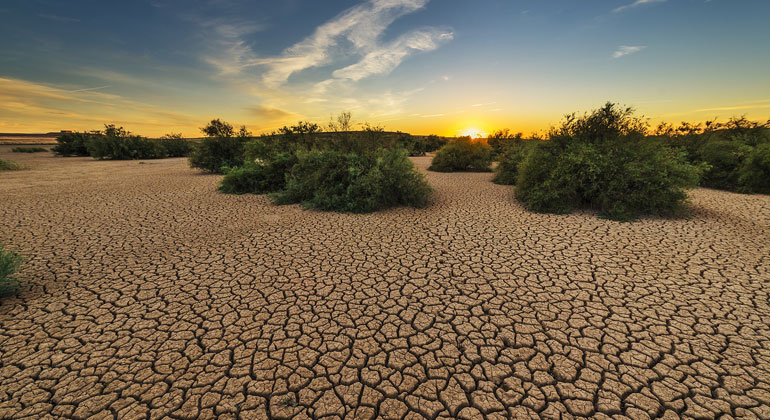Extreme weather and climate change
Extreme weather events are occurring more and more severely. This is often attributed to climate change. However, how does this connection between extreme weather and climate change actually look like?
Linda van Garderen from the Helmholtz-Zentrum Hereon now succeeded in further developing a research method, which – for the first time – attributes climate change to a specific extreme weather event. She showed that climate change intensified an already heavy drought in South America and led to a temperature increase of up to 4 degrees during one of the strongest heatwaves in Europe.
Scientists have often linked climate change to extreme events. These results however were mainly based on statistical methods. They allow statements about the probability of extreme events occurring or how likely it is that they will be more severe in the future. Analyses of individual events regarding climate change were not possible, though. Now Linda van Garderen, scientist at the Hereon Institute of Coastal Systems – Analysis and Modeling, was able to fill the gap with the combined method spectrally nudged storylines. On this basis, she showed that due to climate change the drought in South East South America (SESA) in 2011/ 2012 was more severe, while precipitation increased during the rest of the year. For one of the heaviest heatwaves in Europe so far, she was also able to prove that climate change led to a temperature increase of up to 4°C in certain areas.
“To find a clear climate signal of locally up to 4°C in one of the strongest heat events in recorded European history, shows us how much human action has already altered our planet,” says Linda van Garderen, lead author of the studies.
How it works
With spectrally nudged storylines, van Garderen simulated three different worlds: One without climate change, one with climate change (our world today) and one with severe climate change (global temperature +2°C). In her model, she fixated the large-scale dynamic parameters responsible for the horizontal winds in the higher atmosphere. These complex movements all over the globe are often subject to unpredictable fluctuations and therefore complicate the simulation of the climate in certain areas. By keeping them close to observations, the model allows to focus on the concrete thermodynamic data, like temperature and humidity. This minimizes the so-called noise, the interference factors that overlay the actual signals. “Spectrally nudged storylines find the climate signal in individual extreme events, where with other methods that signal would be lost in the noise,” explains van Garderen.
Mean temperature in Southeastern South America during drought of 2011/2012 | Simulation of the daily mean temperature for a world without climate change, a world as we know it today and a world with +2°C global warming.
This way, van Garderen was able to recreate the three worlds over the period of five years (2010-2014). She concentrated on severe extreme events of the past and compared the outcomes of each world. In addition to demonstrating that climate change has intensified specific weather extreme events in the past, van Garderen also showed that the consequences would have been even more drastic in a 2 degree world: Regarding the drought in the SESA region, local temperatures would have reached up to 3 degrees warmer compared to our situation today, leading to an increased evaporation of moist out of the soil and vegetation. Eventually, this could have intensified the drought even more.
Resilience is key
The significance about van Garderen’s work and her results so far, is the analysis of concrete events. Even though statistical analyses provide valuable insights into the climate of our future, they offer comparatively little information for the attribution of individual extreme events to climate change. In order to be able to react appropriately to the consequences of climate change, it is crucial to provide a preparation that is extensive and best suited for the corresponding region. Resilient structures in society, the economy and agriculture are crucial to be able to mitigate or even prevent the worst consequences of extreme events.
Background
Linda van Garderen’s findings are the results of her PhD thesis under the supervision of Dr. Frauke Feser, scientist at the Hereon Institute of Coastal Systems – Analysis and Modeling and under the cosupervision of Prof. Ted Shepherd, Grantham Professor of Climate Science at the University of Reading. Shepherd first created the method storylines in 2017 to find the effect of climate change given a specific circumstance – i.e. two degree warming or an active El Niño – instead of trying to predict the future with all its uncertainties. Even before that, Feser developed spectral nudging together with Hans von Storch and Heike Langenberg and later supervised van Garderen’s application and adaptation of global spectral nudging. This method was used to recreate the global weather of the past, tracking the change of weather over time more accurately.
- Original publication Van Garderen, L., Mindlin, J. (2022). A storyline attribution of the 2011/2012 drought in Southeastern South America. Weather.
- Original publication Van Garderen, L., Feser, F., Shepherd, T.G. (2021). A methodology for attributing the role of climate change in extreme events: a global spectrally nudged storyline. Nat. Hazards Earth Syst. Sci. 21(1): 171– 186.
- Institute of Coastal Systems – Analysis and Modeling Department for Climate Extremes and Impacts








